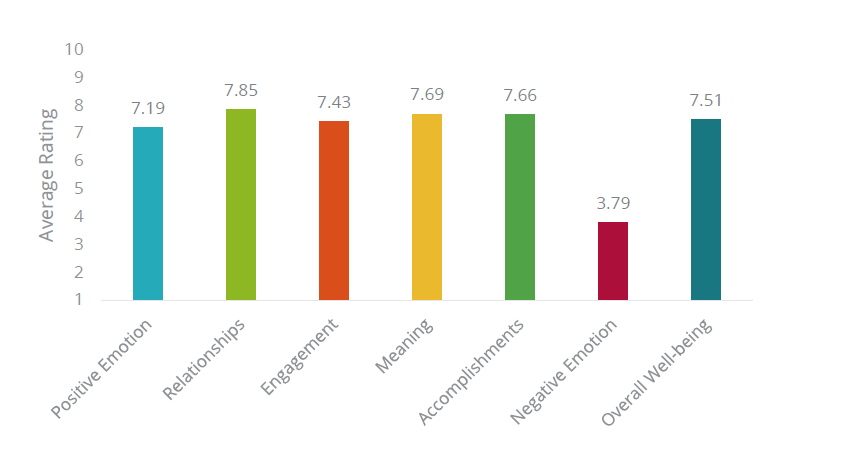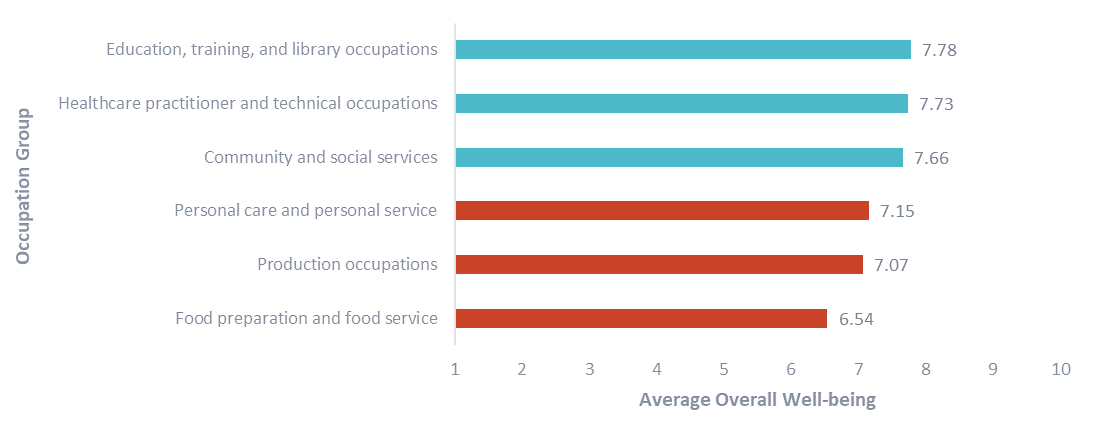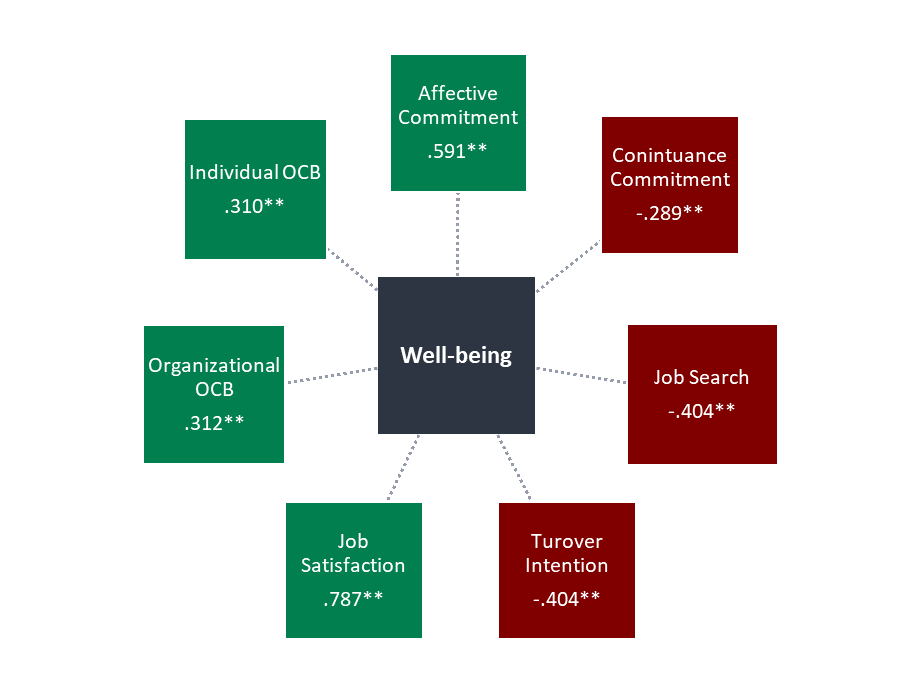Happier Employees Build Organizational Success
Martin Boult
Organizations have been spending more than $40 billion (USD) per year on “wellness and well-being” initiatives for their employees1? Investing in employee’s well-being improves their efforts at work and the performance of their organization.
Why is that?
Research2 shows that the level of well-being your people experience at work affects:
- staff discretionary effort
- productivity
- creativity
- cooperation
- retention of talent
- employee health
- profitability
So happier employees can have a positive effect on the company’s bottom line, but don’t blow your budget on office chefs and ping-pong tables yet. What enhances or hinders your employees’ well-being may surprise you.
Our three-year international study looked into how workplace well-being affects company performance and activities that improve well-being. The study (involving more than 10,000 people from 131 countries) builds on previous research3 and found people’s workplace well-being comprises the factors of:
- Positive Emotions –frequent feelings of happiness, contentment, pleasure
- Relationships – mutual feelings of caring, support, satisfaction
- Engagement – deep psychological connection and absorption in an activity or cause
- Meaning – having a sense of purpose and direction
- Accomplishment – pursuing success or mastery for its own sake
- Negative Emotions – low levels of anxiety, pessimism, depression
We refer to these well-being factors as PREMAN.
We also gained new insights about what affects people’s well-being and how they improve it at work.
New insights: Relationships at work are key to well-being
First, the Relationships factor was consistently rated the highest aspect of well-being (Figure 1). Organizations need to deliberately create work environments that nurture and support healthy social relationships.
Leaders must build cultures and teams that foster constructive relationships. The should give employees the opportunity to establish and maintain positive relationships with their co-workers.
Compared to the other well-being factors, Positive Emotions was the lowest rated aspect of well-being. While emotional experiences start within each person, leaders should be aware of the type of relationships, work practices, policies and cultural norms supporting their employee’s enjoyment, optimism and happiness at work.

Figure 1. Average rating of well-being factors for the global sample (2016-2018) – Note: low scores on Negative Emotion indicate lower frequency of emotions that negatively impact well-being.
Older, wiser and happier
We also found well-being increases with age. People aged 65 years and older reported the highest levels of well-being. People aged 18-24 years reported the lowest levels well-being.
With multiple generations working together today, you can improve well-being by creating opportunities for younger people to learn from their older colleagues. We see many organizations not tapping into opportunities to share learning between employees of different age groups.
What occupations have the highest well-being?
People in service-related work (such as, healthcare, education and training) tended to report the highest well-being. Occupations where people experience relatively lower well-being typically involve more practical and physically oriented work (such, as production) (Figure 2).

Figure 2. The three occupation groups rating the highest level of well-being and the three occupations groups rating the lowest level of well-being.
What does this mean for people working in occupations with relatively lower well-being?
Organisations employing people in these types of jobs should take time to find and address what may inhibit their staff from experiencing optimal well-being. This involves accurately evaluating well-being in the organisation using a reliable and valid well-being assessment and partnering with an organization that specializes in employee development.
But well-being is not only the responsibility of the employer. We also see people improve their well-being when they take responsibility to manage it inside and outside of work.
Does your personality affect your workplace well-being?
People with a preference for extraversion (measured by MBTI® assessment), reported slightly higher well-being than those with a preference for introversion. This shouldn’t surprise you, as many organisations’ environments support the needs of extraverted people. How often do you expect your employees to frequently participate in meetings, collaborate, brainstorm out loud and make decisions in teams? These type of activities play to the strengths of extraverted people.
With roughly half the working population preferring introversion, there are going to be many ways organizations can enhance the well-being of their introverted employees. Some practical tips include, allowing people to have workspaces where they can focus without being interupted, or pausing during meetings for people to write their ideas down before sharing.
Your MBTI® personality type also influences the kind of activities at work that are most effective for improving your well-being4. Our research highlights it is essential to consider what well-being activities are most effective for different personality types to avoid a “one-size fits all” approach or investing in ineffective “wellness” initiatives.
How does well-being affect organizational performance?
We found higher levels of well-being at work related to important organizational outcomes (summarized in Figure 3).:
- Increased job satisfaction
- Intention to stay with your current organization
- Increased individual and organisational citizenship behaviours, particularly discretionary effort
Research shows when people experience these elements at work, organizational performance improves.

Figure 3. Correlations between Overall Workplace Well-being and Organizational Outcomes. Green factors have a positive effect and red factors a negative effect for organizational performance.
How can your well-being at work improve?
Leaders can improve staff well-being and help their companies perform better by accurately evaluating the well-being of their people. When we’ve presented our well-being evaluation results to leaders, they’re often surprised to learn what’s influencing the well-being of their staff.
Making a few inexpensive and practical adjustments to the workplace often increases well-being a great deal. Our research shows the most effective ways to improve well-being for staff, regardless of their age or personality type, include:
- Focusing on work tasks that interest me
- Focusing on a work task that makes me feel positive
- Undertaking work where I learn something new
- Taking breaks at work when needed
- Undertaking challenging work that adds to my skills and knowledge
If you want to improve your own well-being, take time to find your intrinsic work interests, development needs and opportunities to learn throughout your career.
For employers and managers, it’s crucial to learn your employees’ interests and development needs. Then you can create opportunities for employees to shape their work and align it with their interests and what they value learning.
So if you want to improve well-being in your organization:
- Evaluate the current level of your staff well-being using the PREMAN well-being factors annually
- Identify what aspects of your organization are helping or hindering well-being.
- Then invest in evidence-based activities that enhance well-being for your staff.
1 Global Wellness Institute (2016) The future of wellness at work.
2 (Amabile, Barsade, Mueller, & Staw, 2005; Bryson et al., 2014; Diener & Tay, 2012; Heintzelman & King, 2014; Khaw & Kern, 2015; Lyubomirsky, King, & Diener, 2005; Seligman, 2011; Swart & Rothmann 2012) (Diener, 2000; Lyubomirsky, 2001; Seligman, 2011)
3 Seligman, (2011) Flourish: A vision new understanding of happiness and well-being.
4 Boult, Thompson & Schaubhut (2018), Workplace Well-being: Why it for organizational performance and how to improve it.